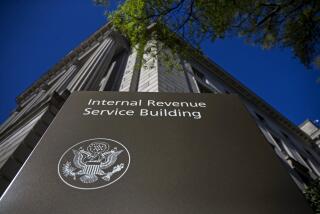Rapid Growth of IRAs Declining, Survey Says
- Share via
Consumers who do not have individual retirement accounts are very reluctant to open them, primarily because they don’t have enough money, a new survey said Thursday.
However, it said, those with IRAs are becoming increasingly risk-oriented, boosting the proportion of their funds in stocks, bonds and other investments with unpredictable returns.
These and other findings, released by the Investment Company Institute, a Washington-based trade group representing the mutual fund industry, suggest that the once phenomenal rate of growth of money in IRAs will continue to slow this year.
They also suggest that IRA rules may have to be liberalized to induce more consumers to open the tax-deferred accounts and that competition for IRA deposits between banks, mutual funds, insurance companies and others will intensify as they battle to take deposits from the same pool of customers.
An increasing marketing focus at institutions offering IRA accounts “is to get customers to switch from another institution” as opposed to targeting customers without IRAs, said Steven E. Norwitz, a vice president at Baltimore-based T. Rowe Price Associates Inc., a major mutual fund company.
“The big rush (among consumers opening first-time accounts) is over,” said Alfred Johnson, vice president and chief economist for the institute. “The ones with money have got in already. Growth from here on will be a bit slower.”
The institute’s survey of nearly 3,500 consumers, conducted last November, also found that consumers who would benefit most from IRAs are least likely to have them.
Such information about the growth and investment mix of IRA funds is becoming increasingly significant for economic policy as IRAs are becoming one of the largest pools of savings available for reinvestment in the economy.
IRA deposits totaled $132.1 billion at the end of 1984, up about $41 billion, or 44.6%, from the end of 1983, according to the institute. Some analysts expect the total to increase by as much as another $40 billion this year, or about 30%, with much of the growth coming in the peak IRA season between now and April 15, the deadline that IRA contributions can be used to reduce taxable income for 1984.
But the survey found that growth in IRA funds is increasingly coming from additional contributions from those already having accounts rather than from those yet to open them. About 82 million households, or 72% of the total households, have not yet opened an IRA, according to the institute.
“Most non-owners (of IRAs) said that it was not at all likely that they would open an IRA in the 1984 tax year,” the survey said. Nearly half of these non-holders said they need to obtain extra money, while more than 10% said they would have to cut spending or have their spouses work to obtain supplemental income.
Only about 5% of the non-IRA owners said the realization that the opportunity for a tax break on 1984 income was slipping away would prompt them to open an IRA.
“If income is not sufficient to open an IRA, the availability of the tax break is obviously not relevant,” the survey said.
The survey suggested that allowing investors to contribute more than $2,000 per year to their IRAs would significantly boost the size of IRA funds. Nearly 70% of those holding IRAs put in the full $2,000 allowed per year, the survey found.
The survey also found that many investors would increase their contributions if the annual maximum was increased to $2,000 for a non-working spouse. (Non-working spouses are now limited to only $250.) The Reagan Administration has proposed increasing the maximums to $2,500 for each spouse whether they work or not. That is expected to be debated in Congress this year.
Analysts note that many individuals who have amassed sizable IRA accounts--larger than $8,000 in many cases--are increasingly seeking to diversify their IRA funds into such investments as stock and bond mutual funds, real estate partnerships and annuities.
Such diversification, along with the growing number of transfers between different IRA accounts, has intensified market-share battles as mutual funds, insurance firms and others try to wrest IRA funds away from banks and S&Ls;, which have nearly 60% of all IRA monies.
More than $40 billion of IRA monies invested in bank certificates of deposit is due to expire this year, according to Wesley Howard, editor of the IRA Reporter, a Cleveland-based newsletter.
To keep this business, banks and S&Ls; are offering stock and bond funds as well as other inducements, such as IRA insurance and deposit minimums of as low as $25 per account. Some, such as Los Angeles-based Union Federal Savings & Loan Assn., are allowing customers to open IRA accounts with credit cards.
“It’s going to be a tougher sell for institutions to get new IRA customers,” Howard of the IRA Reporter says.
Other findings of the survey were:
- Ownership of IRAs is highest for investors in their 50s, with nearly half of all households in this group having the accounts, compared to only about a fourth of those in their 30s and 12% of those under 30.
- Not surprisingly, ownership of IRAs occurs with greater frequency as income levels rise. About two-thirds of households with incomes over $50,000 have an IRA, compared to one-fourth of all households with incomes between $15,000 and $30,000 and only 8% of households under $15,000. Thus, the survey said, those who need IRAs the most lack the funds to invest in them.
More to Read
Inside the business of entertainment
The Wide Shot brings you news, analysis and insights on everything from streaming wars to production — and what it all means for the future.
You may occasionally receive promotional content from the Los Angeles Times.









